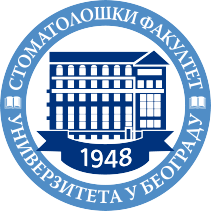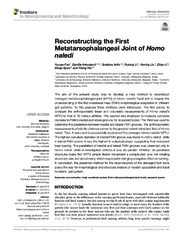Reconstructing the First Metatarsophalangeal Joint of Homo naledi
2019
Аутори
Fan, Yuxuan
Antonijević, Đorđe
Antić, Svetlana

Li, Ruining
Liu, Yawing
Li, Zhiyu
Durić, Marija
Fan, Yifang

Чланак у часопису (Објављена верзија)
Метаподаци
Приказ свих података о документуАпстракт
The aim of the present study was to develop a new method to reconstruct damaged metatarsophalangeal joint (MTPJ) of Homo naledi's fossil and to deepen the understanding of the first metatarsal head (FMH) morphological adaptation in different gait patterns. To this purpose three methods were introduced. The first served to compare the anthropometric linear and volumetric measurements of Homo naledi's MTPJ to that of 10 various athletes. The second was employed to measure curvature diameter in FMH's medial and lateral grooves for sesamoid bones. The third was used to determine the parallelism between medial and lateral FMH grooves. The anthropometric measurements of middle-distance runner to the greatest extent mimicked that of Homo naledi. Thus, it was used to successfully reconstruct the damaged Homo naledi's MTPJ. The highest curvature diameter of medial FMH groove was found in Homo naledi, while in lateral FMH groove it was the highest in volleyball player, suggesting their increased... bear loading. The parallelism of medial and lateral FMH grooves was observed only in Homo naledi, while in investigated athletes it was dis-parallel. Athletes' dis-paralleled structures make first MTPJ simple flexion movement a complicated one: not rotating about one axis, but about many, which may result in bringing a negative effect on running. In conclusion, the presented method for the reconstruction of the damaged foot bone paves the way for morphological and structural analysis of modern population and fossil hominins' gait pattern.
Кључне речи:
reconstruction / body coordinate system / first metatarsophalangeal joint / fossil / sesamoid grooveИзвор:
Frontiers in Bioengineering & Biotechnology, 2019, 7Издавач:
- Frontiers Media Sa, Lausanne
Финансирање / пројекти:
- National Natural Science Foundation of ChinaNational Natural Science Foundation of China [11172073]
- Fujian Provincial Department of Science and Technology [2019J01429]
- Функционални, функционализовани и усавршени нано материјали (RS-MESTD-Integrated and Interdisciplinary Research (IIR or III)-45005)
DOI: 10.3389/fbioe.2019.00167
ISSN: 2296-4185
PubMed: 31355195
WoS: 000475373400001
Scopus: 2-s2.0-85069981425
Колекције
Институција/група
Stomatološki fakultetTY - JOUR AU - Fan, Yuxuan AU - Antonijević, Đorđe AU - Antić, Svetlana AU - Li, Ruining AU - Liu, Yawing AU - Li, Zhiyu AU - Durić, Marija AU - Fan, Yifang PY - 2019 UR - https://smile.stomf.bg.ac.rs/handle/123456789/2392 AB - The aim of the present study was to develop a new method to reconstruct damaged metatarsophalangeal joint (MTPJ) of Homo naledi's fossil and to deepen the understanding of the first metatarsal head (FMH) morphological adaptation in different gait patterns. To this purpose three methods were introduced. The first served to compare the anthropometric linear and volumetric measurements of Homo naledi's MTPJ to that of 10 various athletes. The second was employed to measure curvature diameter in FMH's medial and lateral grooves for sesamoid bones. The third was used to determine the parallelism between medial and lateral FMH grooves. The anthropometric measurements of middle-distance runner to the greatest extent mimicked that of Homo naledi. Thus, it was used to successfully reconstruct the damaged Homo naledi's MTPJ. The highest curvature diameter of medial FMH groove was found in Homo naledi, while in lateral FMH groove it was the highest in volleyball player, suggesting their increased bear loading. The parallelism of medial and lateral FMH grooves was observed only in Homo naledi, while in investigated athletes it was dis-parallel. Athletes' dis-paralleled structures make first MTPJ simple flexion movement a complicated one: not rotating about one axis, but about many, which may result in bringing a negative effect on running. In conclusion, the presented method for the reconstruction of the damaged foot bone paves the way for morphological and structural analysis of modern population and fossil hominins' gait pattern. PB - Frontiers Media Sa, Lausanne T2 - Frontiers in Bioengineering & Biotechnology T1 - Reconstructing the First Metatarsophalangeal Joint of Homo naledi VL - 7 DO - 10.3389/fbioe.2019.00167 ER -
@article{
author = "Fan, Yuxuan and Antonijević, Đorđe and Antić, Svetlana and Li, Ruining and Liu, Yawing and Li, Zhiyu and Durić, Marija and Fan, Yifang",
year = "2019",
abstract = "The aim of the present study was to develop a new method to reconstruct damaged metatarsophalangeal joint (MTPJ) of Homo naledi's fossil and to deepen the understanding of the first metatarsal head (FMH) morphological adaptation in different gait patterns. To this purpose three methods were introduced. The first served to compare the anthropometric linear and volumetric measurements of Homo naledi's MTPJ to that of 10 various athletes. The second was employed to measure curvature diameter in FMH's medial and lateral grooves for sesamoid bones. The third was used to determine the parallelism between medial and lateral FMH grooves. The anthropometric measurements of middle-distance runner to the greatest extent mimicked that of Homo naledi. Thus, it was used to successfully reconstruct the damaged Homo naledi's MTPJ. The highest curvature diameter of medial FMH groove was found in Homo naledi, while in lateral FMH groove it was the highest in volleyball player, suggesting their increased bear loading. The parallelism of medial and lateral FMH grooves was observed only in Homo naledi, while in investigated athletes it was dis-parallel. Athletes' dis-paralleled structures make first MTPJ simple flexion movement a complicated one: not rotating about one axis, but about many, which may result in bringing a negative effect on running. In conclusion, the presented method for the reconstruction of the damaged foot bone paves the way for morphological and structural analysis of modern population and fossil hominins' gait pattern.",
publisher = "Frontiers Media Sa, Lausanne",
journal = "Frontiers in Bioengineering & Biotechnology",
title = "Reconstructing the First Metatarsophalangeal Joint of Homo naledi",
volume = "7",
doi = "10.3389/fbioe.2019.00167"
}
Fan, Y., Antonijević, Đ., Antić, S., Li, R., Liu, Y., Li, Z., Durić, M.,& Fan, Y.. (2019). Reconstructing the First Metatarsophalangeal Joint of Homo naledi. in Frontiers in Bioengineering & Biotechnology Frontiers Media Sa, Lausanne., 7. https://doi.org/10.3389/fbioe.2019.00167
Fan Y, Antonijević Đ, Antić S, Li R, Liu Y, Li Z, Durić M, Fan Y. Reconstructing the First Metatarsophalangeal Joint of Homo naledi. in Frontiers in Bioengineering & Biotechnology. 2019;7. doi:10.3389/fbioe.2019.00167 .
Fan, Yuxuan, Antonijević, Đorđe, Antić, Svetlana, Li, Ruining, Liu, Yawing, Li, Zhiyu, Durić, Marija, Fan, Yifang, "Reconstructing the First Metatarsophalangeal Joint of Homo naledi" in Frontiers in Bioengineering & Biotechnology, 7 (2019), https://doi.org/10.3389/fbioe.2019.00167 . .



